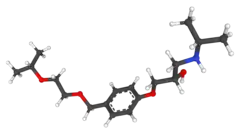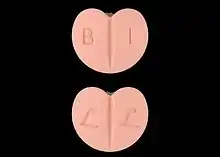Bisoprolol
Bisoprolol, sold under the brand name Zebeta among others, is a beta blocker medication used for heart diseases.[4] This includes high blood pressure, chest pain from not enough blood flow to the heart, and heart failure.[4][5] It is taken by mouth.[4]
 | |
 | |
| Clinical data | |
|---|---|
| Trade names | Zebeta, Concor, others |
| AHFS/Drugs.com | Monograph |
| MedlinePlus | a693024 |
| License data |
|
| Pregnancy category |
|
| Routes of administration | By mouth |
| ATC code | |
| Legal status | |
| Legal status |
|
| Pharmacokinetic data | |
| Bioavailability | >90% |
| Protein binding | 30%[1] |
| Metabolism | 50% liver, CYP2D6, CYP3A4[2] |
| Elimination half-life | 10–12 hours[3] |
| Excretion | Kidney, fecal (<2%) |
| Identifiers | |
IUPAC name
| |
| CAS Number | |
| PubChem CID | |
| IUPHAR/BPS | |
| DrugBank | |
| ChemSpider | |
| UNII | |
| KEGG | |
| ChEBI | |
| ChEMBL | |
| CompTox Dashboard (EPA) | |
| ECHA InfoCard | 100.108.941 |
| Chemical and physical data | |
| Formula | C18H31NO4 |
| Molar mass | 325.449 g·mol−1 |
| 3D model (JSmol) | |
| Chirality | Racemic mixture |
SMILES
| |
InChI
| |
| (verify) | |
Common side effects include headache, feeling tired, diarrhea, and swelling in the legs.[4] More severe side effects include worsening asthma, blocking the ability to recognize low blood sugar, and worsening heart failure.[6] There are concerns that use during pregnancy may be harmful to the baby.[7] Bisoprolol is in the beta blocker family of medications and is of the β1 selective type.[4]
Bisoprolol is on the World Health Organization's List of Essential Medicines.[8] Bisoprolol is available as a generic medication.[4][9] In 2019, it was the 249th most commonly prescribed medication in the United States, with more than 1 million prescriptions.[10][11]
Medical uses

Bisoprolol is currently used for prevention of cardiovascular events following a heart attack in patients with risk factors for disease progression,[12] in the management of congestive heart failure with reduced ejection fraction,[13] and as a second-line agent for hypertension.[14]
Bisoprolol may be beneficial in the treatment of high blood pressure, but it is not recommended as a first-line anti-hypertensive agent without an accompanying comorbid condition, for example, congestive heart failure.[15][16]
In cardiac ischemia, the drug is used to reduce the activity of the heart muscle, so reduced oxygen and nutrient demand, and reduced blood supply can still transport sufficient amounts of oxygen and nutrients.[17][18][19]
Side effects
An overdose of bisoprolol can lead to fatigue, hypotension,[18] hypoglycemia,[20][21] bronchospasms, and bradycardia.[18] Bronchospasms and hypoglycemia occur because at high doses, the drug can be an antagonist for β2 adrenergic receptors located in the lungs and liver. Bronchospasm occurs due to the blockage of β2 receptors in the lungs. Hypoglycemia occurs due to decreased stimulation of glycogenolysis and gluconeogenesis in the liver via β2 receptors.[17][18][22]
Cautions
Non-selective beta-blockers should be avoided in people with asthma or bronchospasm as they may cause exacerbations and worsening of symptoms.[23][24][25] A β1 selective beta-blocker like bisoprolol may be cautiously tried in those with controlled, mild-to-moderate asthma with cardiac comorbidities.[22] A 2014 meta-analysis found that cardioselective beta-blockers may cause detrimental changes in lung function and partially blunts β2-agonist response.[26] However, a 2017 control study found no significant association with asthma exacerbations by dose and exposure duration while a 2020 clinical trial found bisoprolol being non-inferior to placebo in bronchodilator response to salbutamol.[27][28]
Pharmacology
Mechanism of action
Bisoprolol is cardioprotective because it selectively and competitively blocks catecholamine (adrenaline) stimulation of β1 adrenergic receptors (adrenoreceptors), which are mainly found in the heart muscle cells and heart conduction tissue (cardiospecific), but also found in juxtaglomerular cells in the kidney.[17] Normally, adrenaline and noradrenaline stimulation of the β1 adrenoreceptor activates a signalling cascade (Gs protein and cAMP) which ultimately leads to increased myocardial contractility and increased heart rate of the heart muscle and heart pacemaker, respectively.[29] Bisoprolol competitively blocks the activation of this cascade, so decreases the adrenergic tone/stimulation of the heart muscle and pacemaker cells. Decreased adrenergic tone shows less contractility of heart muscle and lowered heart rate of pacemakers.[20][21][30]
β1-selectivity
Bisoprolol β1-selectivity is especially important in comparison to other nonselective beta blockers. The effects of the drug are limited to areas containing β1 adrenoreceptors, which is mainly the heart and part of the kidney.[20][30] Bisoprolol, whilst β1 adrenoceptor selective can help patients to avoid certain side-effects associated with non-selective beta-blocker activity[3] at additional adrenoceptors (α1 and β2), it does not signify its superiority in treating beta-blocker indicated cardiac conditions such as heart failure but could prove beneficial to patients with specific comorbidities.[31][32]
Bisoprolol has a higher degree of β1-selectivity compared to atenolol, metoprolol and betaxolol. With a selectivity ranging from being 11-15 times more selective for β1over β2 [30][33][34][35][36][37][38][39][40][41] However nebivolol is approximately 3.5 times more β1-selective.[42][43]
Renin-angiotensin system
Bisoprolol inhibits renin secretion by about 65% and tachycardia by about 30%.[33]
Pharmacokinetics
After ingestion, bisoprolol is absorbed and has a high bioavailability of approximately 90% with plasma half-life of 10-12 hours.[20][21] When being eliminated, the body evenly distributes it (50–50) between kidney excretion and liver biotransformation (then excreted).[20][21][30]
Bisoprolol has both lipid- and water-soluble properties.[20][30]
The plasma protein binding of bisoprolol is approximately 35%, the volume of distribution is 3.5 L/kg and the total clearance is approximately 15 L/h. Bisoprolol is eliminated from the body in two ways - 50% of the substance is converted in the liver to inactive metabolites, which are then excreted in the kidneys. The remaining 50% is eliminated unchanged via the kidneys.[44] Since elimination is equal in liver and kidney, no dose adjustment is required in patients with hepatic or renal impairment.
The pharmacokinetics of bisoprolol are linear and independent of age.[3]
In patients with chronic heart failure (NYHA stage III), the plasma level of bisoprolol is higher and the half-life is longer than in healthy subjects. At a daily dose of 10 mg, the steady-state peak plasma concentration is 64±21 ng/mL and the half-life is 17±5 hours.
History
Bisoprolol was patented in 1976 and approved for medical use in 1986.[45] It was approved for medical use in the United States in 1992.[4]
Brand names
In India, it is sold under trade name Bisotab and is available in 2 strengths of 2.5 mg and 5 mg.[46]
In Italy, it is sold under trade name Congescor and is available in 6 strengths of 1.25 mg, 2.5 mg, 3.75 mg, 5 mg, 7.5 mg and 10 mg.
In Germany and Eastern Europe bisoprolol is marketed as Bisoprolol-ratiopharm by Ratiopharm (Teva).
References
- Bühring KU, Sailer H, Faro HP, Leopold G, Pabst J, Garbe A (1986). "Pharmacokinetics and metabolism of bisoprolol-14C in three animal species and in humans". Journal of Cardiovascular Pharmacology. 8 (Suppl 11): S21–S28. doi:10.1097/00005344-198511001-00004. PMID 2439794. S2CID 38147937.
- Horikiri Y, Suzuki T, Mizobe M (March 1998). "Pharmacokinetics and metabolism of bisoprolol enantiomers in humans". Journal of Pharmaceutical Sciences. 87 (3): 289–294. doi:10.1021/js970316d. PMID 9523980.
- Leopold G (1986). "Balanced pharmacokinetics and metabolism of bisoprolol". Journal of Cardiovascular Pharmacology. 8 (Suppl 11): S16–S20. doi:10.1097/00005344-198511001-00003. PMID 2439789. S2CID 25731558.
- "Bisoprolol Fumarate". The American Society of Health-System Pharmacists. Archived from the original on 21 December 2016. Retrieved 8 December 2016.
- "Bisoprolol 2.5mg/5mg/10mg film coated tablet - Summary of Product Characteristics (SPC) - (eMC)". medicines.org.uk. 18 February 2014. Archived from the original on 20 December 2016. Retrieved 14 December 2016.
- "Bisoprolol - FDA prescribing information, side effects and uses". drugs.com. Archived from the original on 21 December 2016. Retrieved 14 December 2016.
- "Bisoprolol (Zebeta) Use During Pregnancy". drugs.com. Archived from the original on 21 December 2016. Retrieved 14 December 2016.
- World Health Organization (2019). World Health Organization model list of essential medicines: 21st list 2019. Geneva: World Health Organization. hdl:10665/325771. WHO/MVP/EMP/IAU/2019.06. License: CC BY-NC-SA 3.0 IGO.
- "Drugs@FDA: FDA Approved Drug Products". Archived from the original on 2015-02-25. Retrieved 2013-11-13.
- "The Top 300 of 2019". ClinCalc. Retrieved 16 October 2021.
- "Bisoprolol - Drug Usage Statistics". ClinCalc. Retrieved 16 October 2021.
- Bangalore S, Makani H, Radford M, Thakur K, Toklu B, Katz SD, et al. (October 2014). "Clinical outcomes with β-blockers for myocardial infarction: a meta-analysis of randomized trials". The American Journal of Medicine. 127 (10): 939–953. doi:10.1016/j.amjmed.2014.05.032. PMID 24927909.
- CIBIS-II Investigators (January 1999). "The cardiac insufficiency bisoprolol study II (CIBIS-II): a randomised trial". The Lancet. 353 (9146): 9–13. doi:10.1016/S0140-6736(98)11181-9. S2CID 10083527.>
- Wiysonge CS, Bradley HA, Volmink J, Mayosi BM, Opie LH (January 2017). "Beta-blockers for hypertension". The Cochrane Database of Systematic Reviews. 1: CD002003. doi:10.1002/14651858.CD002003.pub5. PMC 5369873. PMID 28107561.
- Kishi T, Fujii E (April 2019). "Carvedilol and bisoprolol as initial therapy for adult hypertension without compelling indications". Hypertension Research. 42 (4): 496–503. doi:10.1038/s41440-018-0174-6. PMID 30948819. S2CID 96434952.
- Wiysonge CS, Bradley HA, Volmink J, Mayosi BM, Opie LH (January 2017). "Beta-blockers for hypertension". The Cochrane Database of Systematic Reviews. 1: CD002003. doi:10.1002/14651858.CD002003.pub5. PMC 5369873. PMID 28107561.
- CIBIS Investigators and Committees (October 1994). "A randomized trial of beta-blockade in heart failure. The Cardiac Insufficiency Bisoprolol Study (CIBIS)". Circulation. 90 (4): 1765–1773. doi:10.1161/01.cir.90.4.1765. PMID 7923660.
- Konishi M, Haraguchi G, Kimura S, Inagaki H, Kawabata M, Hachiya H, et al. (June 2010). "Comparative effects of carvedilol vs bisoprolol for severe congestive heart failure". Circulation Journal. 74 (6): 1127–1134. doi:10.1253/circj.cj-09-0989. PMID 20354334.
- Castagno D, Jhund PS, McMurray JJ, Lewsey JD, Erdmann E, Zannad F, et al. (June 2010). "Improved survival with bisoprolol in patients with heart failure and renal impairment: an analysis of the cardiac insufficiency bisoprolol study II (CIBIS-II) trial". European Journal of Heart Failure. 12 (6): 607–616. doi:10.1093/eurjhf/hfq038. hdl:2318/134969. PMID 20354032. S2CID 205048092.
- Leopold G, Pabst J, Ungethüm W, Bühring KU (1986). "Basic pharmacokinetics of bisoprolol, a new highly beta 1-selective adrenoceptor antagonist". Journal of Clinical Pharmacology. 26 (8): 616–621. doi:10.1002/j.1552-4604.1986.tb02959.x. PMID 2878941. S2CID 42159046.
- Leopold G, Ungethüm W, Pabst J, Simane Z, Bühring KU, Wiemann H (September 1986). "Pharmacodynamic profile of bisoprolol, a new beta 1-selective adrenoceptor antagonist". British Journal of Clinical Pharmacology. 22 (3): 293–300. doi:10.1111/j.1365-2125.1986.tb02890.x. PMC 1401121. PMID 2876722.
- Hauck RW, Schulz C, Emslander HP, Böhm M (November 1994). "Pharmacological actions of the selective and non-selective beta-adrenoceptor antagonists celiprolol, bisoprolol and propranolol on human bronchi". British Journal of Pharmacology. 113 (3): 1043–1049. doi:10.1111/j.1476-5381.1994.tb17098.x. PMC 1510470. PMID 7858847.
- Morales DR, Jackson C, Lipworth BJ, Donnan PT, Guthrie B (April 2014). "Adverse respiratory effect of acute β-blocker exposure in asthma: a systematic review and meta-analysis of randomized controlled trials". Chest. 145 (4): 779–786. doi:10.1378/chest.13-1235. PMID 24202435.
- Morales DR, Lipworth BJ, Donnan PT, Jackson C, Guthrie B (January 2017). "Respiratory effect of beta-blockers in people with asthma and cardiovascular disease: population-based nested case control study". BMC Medicine. 15 (1): 18. doi:10.1186/s12916-017-0781-0. PMC 5270217. PMID 28126029.
- Bennett M, Chang CL, Tatley M, Savage R, Hancox RJ (January 2021). "The safety of cardioselective β1-blockers in asthma: literature review and search of global pharmacovigilance safety reports". ERJ Open Research. 7 (1). doi:10.1183/23120541.00801-2020. PMC 7917232. PMID 33681344.
- Morales DR, Jackson C, Lipworth BJ, Donnan PT, Guthrie B (April 2014). "Adverse respiratory effect of acute β-blocker exposure in asthma: a systematic review and meta-analysis of randomized controlled trials". Chest. 145 (4): 779–786. doi:10.1378/chest.13-1235. PMID 24202435.
- Bennett MR, Chang CL, Tuffery C, Hopping S, Hancox RJ (March 2021). "The impact of regular bisoprolol on the response to salbutamol in asthma: A double-blind randomized placebo-controlled crossover trial". Respirology. 26 (3): 225–232. doi:10.1111/resp.13955. PMID 33043552. S2CID 222301890.
- Morales DR, Lipworth BJ, Donnan PT, Jackson C, Guthrie B (January 2017). "Respiratory effect of beta-blockers in people with asthma and cardiovascular disease: population-based nested case control study". BMC Medicine. 15 (1): 18. doi:10.1186/s12916-017-0781-0. PMC 5270217. PMID 28126029.
- Bristow MR, Hershberger RE, Port JD, Minobe W, Rasmussen R (March 1989). "Beta 1- and beta 2-adrenergic receptor-mediated adenylate cyclase stimulation in nonfailing and failing human ventricular myocardium". Molecular Pharmacology. 35 (3): 295–303. PMID 2564629.
- Haeusler G, Schliep HJ, Schelling P, Becker KH, Klockow M, Minck KO, et al. (1986). "High beta 1-selectivity and favourable pharmacokinetics as the outstanding properties of bisoprolol". Journal of Cardiovascular Pharmacology. 8 (Suppl 11): S2-15. doi:10.1097/00005344-198511001-00002. PMID 2439793. S2CID 24617470.
- Taniguchi T, Ohtani T, Mizote I, Kanzaki M, Ichibori Y, Minamiguchi H, et al. (June 2013). "Switching from carvedilol to bisoprolol ameliorates adverse effects in heart failure patients with dizziness or hypotension". Journal of Cardiology. 61 (6): 417–422. doi:10.1016/j.jjcc.2013.01.009. PMID 23548374.
- Düngen HD, Apostolovic S, Inkrot S, Tahirovic E, Töpper A, Mehrhof F, et al. (June 2011). "Titration to target dose of bisoprolol vs. carvedilol in elderly patients with heart failure: the CIBIS-ELD trial". European Journal of Heart Failure. 13 (6): 670–680. doi:10.1093/eurjhf/hfr020. PMC 3101867. PMID 21429992.
- Harting J, Becker KH, Bergmann R, Bourgois R, Enenkel HJ, Fuchs A, et al. (February 1986). "Pharmacodynamic profile of the selective beta 1-adrenoceptor antagonist bisoprolol". Arzneimittel-Forschung. 36 (2): 200–208. PMID 2870720.
- Kaumann AJ, Lemoine H (October 1985). "Direct labelling of myocardial beta 1-adrenoceptors. Comparison of binding affinity of 3H-(-)-bisoprolol with its blocking potency". Naunyn-Schmiedeberg's Archives of Pharmacology. 331 (1): 27–39. doi:10.1007/bf00498849. PMID 2866449. S2CID 22328991.
- Klockow M, Greiner HE, Haase A, Schmitges CJ, Seyfried C (February 1986). "Studies on the receptor profile of bisoprolol". Arzneimittel-Forschung. 36 (2): 197–200. PMID 2870719.
- Manalan AS, Besch HR, Watanabe AM (August 1981). "Characterization of [3H](+/-)carazolol binding to beta-adrenergic receptors. Application to study of beta-adrenergic receptor subtypes in canine ventricular myocardium and lung". Circulation Research. 49 (2): 326–336. doi:10.1161/01.res.49.2.326. PMID 6113900.
- Schliep HJ, Schulze E, Harting J, Haeusler G (April 1986). "Antagonistic effects of bisoprolol on several beta-adrenoceptor-mediated actions in anaesthetized cats". European Journal of Pharmacology. 123 (2): 253–261. doi:10.1016/0014-2999(86)90666-7. PMID 3011461.
- Schliep HJ, Harting J (1984). "Beta 1-selectivity of bisoprolol, a new beta-adrenoceptor antagonist, in anesthetized dogs and guinea pigs". Journal of Cardiovascular Pharmacology. 6 (6): 1156–1160. doi:10.1097/00005344-198406060-00024. PMID 6084774.
- Schnabel P, Maack C, Mies F, Tyroller S, Scheer A, Böhm M (October 2000). "Binding properties of beta-blockers at recombinant beta1-, beta2-, and beta3-adrenoceptors". Journal of Cardiovascular Pharmacology. 36 (4): 466–471. doi:10.1097/00005344-200010000-00008. PMID 11026647.
- Smith C, Teitler M (April 1999). "Beta-blocker selectivity at cloned human beta 1- and beta 2-adrenergic receptors". Cardiovascular Drugs and Therapy. 13 (2): 123–126. doi:10.1023/A:1007784109255. PMID 10372227. S2CID 12639448.
- Wellstein A, Palm D, Belz GG (1986). "Affinity and selectivity of beta-adrenoceptor antagonists in vitro". Journal of Cardiovascular Pharmacology. 8 (Suppl 11): S36–S40. doi:10.1097/00005344-198511001-00006. PMID 2439796. S2CID 30987576.
- Bundkirchen A, Brixius K, Bölck B, Nguyen Q, Schwinger RH (January 2003). "Beta 1-adrenoceptor selectivity of nebivolol and bisoprolol. A comparison of [3H]CGP 12.177 and [125I]iodocyanopindolol binding studies". European Journal of Pharmacology. 460 (1): 19–26. doi:10.1016/S0014-2999(02)02875-3. PMID 12535855.
- Nuttall SL, Routledge HC, Kendall MJ (June 2003). "A comparison of the beta1-selectivity of three beta1-selective beta-blockers". Journal of Clinical Pharmacy and Therapeutics. 28 (3): 179–186. doi:10.1046/j.1365-2710.2003.00477.x. PMID 12795776. S2CID 58760796.
- "Bisoprolol". go.drugbank.com. Retrieved 2022-08-17.
- Fischer J, Ganellin CR (2006). Analogue-based Drug Discovery. John Wiley & Sons. p. 461. ISBN 9783527607495. Archived from the original on 2017-09-08.
- "Bisotab-Physician Information Page". Medical Dialogues. 22 August 2020. Retrieved 22 August 2020.
External links
- "Bisoprolol". Drug Information Portal. U.S. National Library of Medicine.